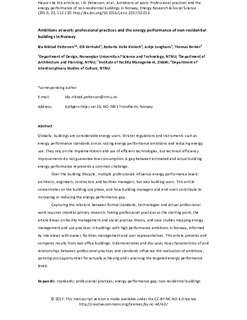| dc.contributor.author | Pettersen, Ida Nilstad | |
| dc.contributor.author | Verhulst, Elli | |
| dc.contributor.author | Valle Kinloch, Roberto | |
| dc.contributor.author | Junghans, Antje | |
| dc.contributor.author | Berker, Thomas | |
| dc.date.accessioned | 2017-10-05T06:55:49Z | |
| dc.date.available | 2017-10-05T06:55:49Z | |
| dc.date.created | 2017-03-13T09:45:08Z | |
| dc.date.issued | 2017 | |
| dc.identifier.citation | Energy Research & Social Science. 2017, 32 112-120. | nb_NO |
| dc.identifier.issn | 2214-6296 | |
| dc.identifier.uri | http://hdl.handle.net/11250/2458542 | |
| dc.description.abstract | Globally, buildings are considerable energy users. Stricter regulations and instruments such as energy performance standards aim at raising energy performance ambitions and reducing energy use. They rely on the implementation and use of efficient technologies, but technical efficiency improvements do not guarantee low consumption. A gap between estimated and actual building energy performance represents a common challenge.
Over the building lifecycle, multiple professionals influence energy performance levels: architects, engineers, contractors and facility managers, but also building users. This article concentrates on the building use phase, and how building managers and end-users contribute to increasing or reducing the energy performance gap.
Capturing the relations between formal standards, technologies and actual professional work requires interdisciplinary research. Taking professional practices as the starting point, the article draws on facility management and social practice theory, and case studies mapping energy management and use practices in buildings with high performance ambitions in Norway, informed by interviews with owner, facility management and user representatives. This article presents and compares results from two office buildings. It demonstrates and discusses how characteristics of and relationships between professional practices and standards influence the realisation of ambitions, pointing out opportunities for actually achieving and sustaining the targeted energy performance levels. | nb_NO |
| dc.language.iso | eng | nb_NO |
| dc.publisher | Elsevier | nb_NO |
| dc.rights | Attribution-NonCommercial-NoDerivatives 4.0 Internasjonal | * |
| dc.rights.uri | http://creativecommons.org/licenses/by-nc-nd/4.0/deed.no | * |
| dc.title | Ambitions at work: Professional practices and the energy performance of non-residential buildings in Norway | nb_NO |
| dc.type | Journal article | nb_NO |
| dc.type | Peer reviewed | nb_NO |
| dc.description.version | acceptedVersion | nb_NO |
| dc.source.pagenumber | 112-120 | nb_NO |
| dc.source.volume | 32 | nb_NO |
| dc.source.journal | Energy Research & Social Science | nb_NO |
| dc.identifier.doi | 10.1016/j.erss.2017.02.013 | |
| dc.identifier.cristin | 1457682 | |
| dc.relation.project | Norges forskningsråd: 228642 | nb_NO |
| dc.description.localcode | © 2017. This manuscript version is made available under the CC‐BY‐NC‐ND 4.0 license http://creativecommons.org/licenses/by‐nc‐nd/4.0/ . Locked until 11 March 2019 due to copyright restrictions. | nb_NO |
| cristin.unitcode | 194,61,45,0 | |
| cristin.unitcode | 194,61,50,0 | |
| cristin.unitcode | 194,62,40,0 | |
| cristin.unitname | Institutt for design | |
| cristin.unitname | Institutt for arkitektur og planlegging | |
| cristin.unitname | Institutt for tverrfaglige kulturstudier | |
| cristin.ispublished | true | |
| cristin.fulltext | postprint | |
| cristin.qualitycode | 1 | |

